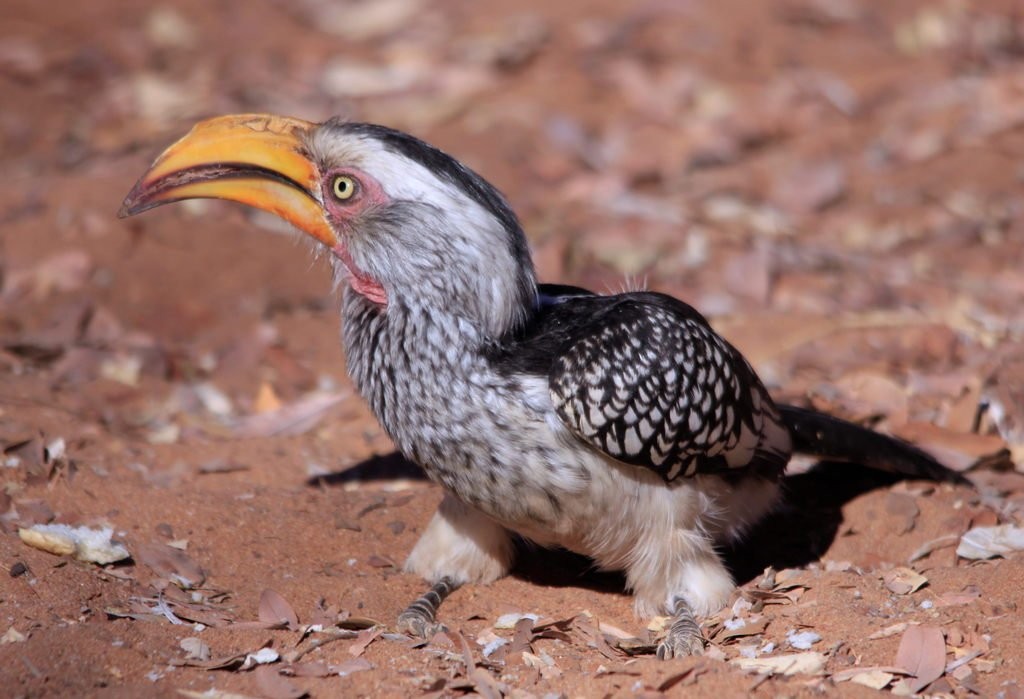Southern Yellow-billed Hornbill
A species of Red-billed and yellow-billed hornbills Scientific name : Tockus leucomelas Genus : Red-billed and yellow-billed hornbills
Southern Yellow-billed Hornbill, A species of Red-billed and yellow-billed hornbills
Botanical name: Tockus leucomelas
Genus: Red-billed and yellow-billed hornbills
Content
Description People often ask General Info
Description
It is a medium-sized bird, 48–60 centimetres (19–24 in) in length, 132–242 grams (0.291–0.534 lb) in weight and is characterized by a long yellow and down-curved beak. This beak is huge in comparison to its body and can account for up 1/6th of the entire body length. Male beaks are on average 90 mm long while female beaks are an average of 74 mm. Males are generally bigger than females but there is overlap between the sexes. The size difference of the beak is a fairly reliable way of differentiating sex in wild hornbills. The casque that characterizes all hornbills is of a very modest size in the southern yellow-billed hornbill. It is small, but it covers almost the entire length of the beak in males (less so in females), and may give the impression that they do not actually have a casque. As in all hornbills, the size of the beak actually intrudes on the frontal vision of the bird and the first two neck vertebrae are fused together. Also, like most other hornbills, they possess a long tail, long eyelashes, stubby legs and stubby toes. The front three toes are fused together near the base. They have white belly, grey neck, and black back plumage with abundant white spots and stripes. The neck has gray spots and the chest is lightly striated with black. Southern yellow-billed hornbills have no plumage pigmentation save for melanin, which can only produce shades of black and white. The eyes are usually yellow, though brown has also been seen. The skin around the eyes and in the malar stripe is pinkish. The related eastern yellow-billed hornbill from north-eastern Africa has blackish skin around the eyes. 
Size
40 cm
Colors
Black
Gray
White
Life Expectancy
20 years
Nest Placement
Cavity
Feeding Habits
Southern Yellow-billed Hornbill predominantly consume arthropods, including termites, beetles, and caterpillars, augmented by small mammals, fruits, and nuts. Utilizing their beak like forceps, they forage mainly on the ground, with adaptations like serrated inner beak edges assisting in food processing.
Habitat
Southern Yellow-billed Hornbill thrives primarily in the dry savannas and semi-deserts of southern Africa. Favouring open areas, these birds are found in regions with scattered trees, often alongside watercourses. In the east, southern Yellow-billed Hornbill occupies savannas and woodlands, including acacia and broadleaved forests. They show a particular preference for mopane scrub habitats. While they are adaptable to various woodland types, southern Yellow-billed Hornbill generally avoids dense forests and wetter regions, persisting in its stronghold within arid to semi-arid environments.
Dite type
Omnivorous
People often ask
General Info
Feeding Habits
Bird food type
Behavior
The southern yellow-billed hornbill is active during morning, day and evening. At night, it will sleep high in a tree so it won't be preyed on. They can be found alone, in couples or in small groups. They generally tend to be loners unless it is breeding season, nesting season or if there is local migration during dry season. The southern yellow-billed hornbill is often seen searching for food on the ground or in shrubs. It will not dig the ground, but it will overturn debris to find insects. It can also be seen pursuing insects by hopping heavily after it. They are generally sedentary and they will defend their territories with elaborate displays. However, during the dry season, they will sometimes range widely in order to find food. Couples are usually monogamous and have a clear division of labour between males and females. They have been known to live for up to 20 years in captivity, though their longevity in the wilds remains unknown. 
Distribution Area
These birds are near endemic to the dry savannas of southern Africa, where they can be found across all longitudes, from Angola and Namibia in the west to Mozambique and KwaZulu-Natal in the east, including Botswana, Zimbabwe and northern South Africa. The southern yellow-billed hornbill lives mostly in the dry, open savannas, but they are also very partial to woodlands when they can find them. When in woodlands, they seem to prefer acacia and broadleaved woodlands. The highest reported concentration of southern yellow-billed hornbill is in open mopane scrub. 
Species Status
Not globally threatened.
